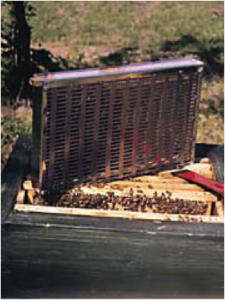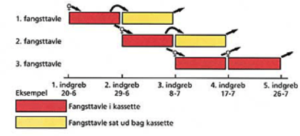CAGING THE QUEEN
Skrevet af: Henrik Hansen & Camilla J. Brødsgaard. Danmarks JordbrugsForskning, Projektgruppe Biavl
AN EFFECTIVE BEEKEEPING INTERVENTION

* Using this method the queen is caged inside a frame for almost four weeks
* The varroa mite numbers can be kept to an acceptable level using queen caging combined with the removal of drone brood.
* Queen caging prevents swarming.
PROCEDURE
- Queen caging can be carried out on one or more framed. Here caging inside a cassette on a single frame is described.
- Queen caging tales place before the Spring oil-seed-rape honey flow. The intervention is carried out every eight or nine days
- In the first intervention the queen is put on a frame inside the cassette
- At the second intervention remove all the queen cells. The first frame is set behind the cassette, and the queen is then put onto the second frame inside the cassette.
- Under the third intervention remove the first frame. The second frame is then placed behind the cassette, and the queen is the placed on the third frame inside the cassette.
- At the fourth intervention remove the second frame. The queen is then released from the cassette, while the third frame remains in the cassette.
- At the fifth intervention remove the cassette and the third frame.

BAIT FRAMES
- The “bait” frames which have been removed can be destroyed. They can also be treated with formic acid or by heat treatment , if there are not dead brood in the frames
- Using formic acid treatment the brood must not be more than 16 to 17 days old.
- Six to seven bait frames are set into an isolated box.
- At the top and the bottom a thin. porous wood fibre board in placed and each is given 25 ml of 85% formic acid solution. The box is then covered with an air tight cover and bottom.
- One hour later the treatment is complete. The frames may only be placed in hives from which a honey harvest is not to be taken.
- Using heat treatment the brood must not be more than 16 – 17 days either. The treatment as described in the section on heat treatment should be followed.

